#Regional Indian Cuisine
Text
How to make Peanut Coriander Chutney Recipe | Verusenaga Kothimeera Pachadi
Peanut Coriander(Moongphali dhaniya)Chutney
Are you looking to spice up your culinary adventures with a burst of flavour? Look no further than the delectable Peanut Coriander(Moongphali dhaniya)Chutney! This versatile condiment combines the rich, nutty goodness of peanuts with the vibrant freshness of coriander, creating a symphony of tastes that will elevate your dishes to new heights.
Peanut…
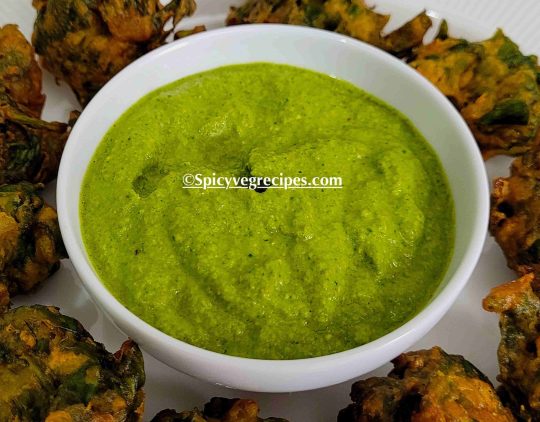
View On WordPress
#Adrak Elachi Chai#Aromatic Tea#Ayurvedic Tea#Chai Latte with Ginger and Cardamom#Chai Tea Blend#Easy Recipes#Flavored Tea#Ginger cardamom tea#Healthy Chai Recipe#healthy recipes#Herbal Infusion#Homemade Chai#Hot Beverage with Ginger and Cardamom#Indian Masala Chai#Indian Spice Infused Tea#Quick Recipes#Refreshing Chai Blend#Regional Indian Cuisine#spiced tea#spicy veg recipes#Tea with Fresh Spices#Tea with Ginger and Cardamom#Traditional Indian Chai#veg recipes#Warm and Soothing Chai#Winter Spice Tea
2 notes
·
View notes
Text
Exploring My Diverse Flavors of Indian Cuisine: My Culinary Journey Through the States
What are your favorite types of foods?
Indian cuisine is renowned for its diversity, flavors, and vibrant culinary traditions, influenced by various regions, cultures, and historical influences. Step into the magical realm of Indian cuisine, a tapestry of flavors that dances on your palate. From the fiery spices of the north to the fragrant coastal dishes of the south, Indian food is an…

View On WordPress
#Apong#Appam#Chettinad Chicken#culinary traditions#dailyprompt#dailyprompt-2061#Dal Baati Churma#Dhokla#flavors of India#Idli Sambar#Indian food#Khar#Macher Jhol#Malabar Fish Curry#Mishti Doi#regional cuisines#traditional dishes#Undhiyu
0 notes
Text
Fish Dishes in India: A Journey Through the Flavors of the Sea
India is a land of diverse cultures and cuisines, and seafood is an integral part of many regional cuisines. With a long coastline and many rivers, India has an abundance of fish and seafood that is used to create a variety of delicious dishes. From the tandoori fish of Punjab to the fish curry of Kerala, the flavors of the sea can be found in every corner of the country.
In this article, we’ll…
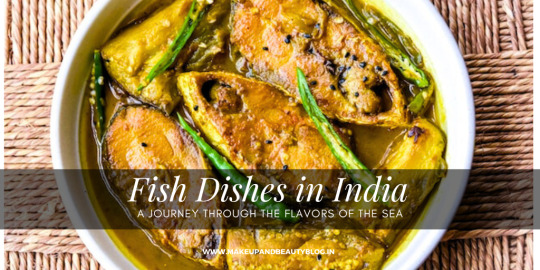
View On WordPress
#BlogchatterA2Z#Fish biryani#Fish dishes#Fish Koliwada#Fish Molee#Fish tikka#Goan fish curry#indian cuisine#Indian seafood#Kerala fish curry#Regional cuisine#Seafood
1 note
·
View note
Text
Stuff You May Wish to Know About Curry
Indian gourmet Sukhi Singh says:
"In its simplest form, curry is an Indian gravy or sauce that is used in tandem with meat, tofu, or vegetables. It’s served rice, most popularly Basmati rice, and contains many different kinds of spices. Depending on what your recipe calls for, you could have a mild curry or a curry that’s super spicy.
There are many different ways to make curry and each region will have its specialty. My family’s Chicken Tikka Masala could vary from your family’s recipe, and that’s okay! Curry is what you make it."
History of curry according to Wikipedia:
Evidence dating back to 2600 BCE from Mohenjo-daro archaeological site in Sindh, Pakistan suggests the use of mortar and pestle to pound spices including mustard, fennel, cumin, and tamarind pods with which they flavored food. Black pepper, or peppercorn, is native to the Indian subcontinent and Southeast Asia and has been known to Indian cooking since at least 2000 BCE.
The three basic ingredients of the spicy stew were ginger, garlic and turmeric. Using a method called "starch grain analysis," archaeologists at the University of Washington at Vancouver were able to identify the residue of these ancient spices in both skeletons and pottery shards from excavations in India. Examining the human teeth and the residue from the cooking pots, signs of turmeric and ginger were evident.
The establishment of the Mughal Empire, in the early 15th century, also influenced some curries, especially in the north. Another influence was the establishment of the Portuguese trading center in Goa in 1510, resulting in the introduction of chili pepper, tomatoes, and potatoes to India from the Americas, as a byproduct of the Columbian Exchange.
The British lumped all sauce-based dishes under the generic name 'curry.' It was introduced to English cuisine from Anglo-Indian cooking in the 17th century, as spicy sauces were added to plain boiled and cooked meats. Curry was first served in coffee houses in Britain from 1809, and has been increasingly popular in Great Britain, with major jumps in the 1940's and the 1970's. During the 19th century, curry was carried to the Caribbean by Indian indentured workers in the British sugar industry. Since the mid-20th century, curries of many national styles have become popular far from their origins, and increasingly become part of international fusion cuisine.
Curry by Indian region, by Table Agent
Northern Indian Cuisine:
Perhaps the most prevalent culinary style found outside of India, Northern Indian cuisine reflects a strong Mughal influence. It is characterized by a high use of dairy: milk, paneer (an Indian mild cheese), ghee (clarified butter), and yogurt are all used regularly in Northern dishes. Samosas, fried pastries stuffed with potatoes and occasionally meat, are a distinctive Northern snack. Clay ovens known as tandoors are popular in the North, giving dishes like Tandoori Chicken and Naan bread their distinctive charcoal flavor. A significant number of Northern dishes make regular appearances on Indian menus. Dal or Paneer Makhani are popular vegetarian dishes, consisting of dal or paneer cooked in a creamy sauce of tomatoes, onions, mango powder, and garam masala. Saag Paneer and Palak Paneer are two similar dishes made with spinach, cream, and paneer, differing slightly in consistency and spices. Korma, another menu staple from Northern India, is a creamy curry of coconut milk or yogurt, cumin, coriander, and small amounts of cashews or almonds. It can be served with different meats, usually chicken or lamb, but sometimes beef, as well as with paneer for a vegetarian dish.
Western Indian Cuisine:
Western Indian cuisine is distinguished by the geographic and historical particulars of its three main regions: Maharashtra, Gujarat, and Goa. Maharashtra’s coastal location is responsible for its fish and coconut milk-dominant cuisine. Gujarati cuisine is mostly vegetarian and has an underlying sweetness to many of its dishes due to Chinese influence. Since the dry climate of this region produces smaller vegetables, this region is well known for its chutneys, which are popular Indian condiments that use cooked, fresh, or pickled vegetables and fruits with sweet, sour, or spicy flavors. Goa acted as a major trade port and colony for Portugal, resulting in a distinctive and unique blend of Indian and Portuguese culinary elements. Goan cuisine uses pork and beef with greater frequency than other regional cuisines in India. Vinegar is also a characteristic ingredient of Goan cuisine, another result of Portuguese influence. The prevalence of coconut milk, coconut paste, and fish in Goan cuisine results from its coastal location. Vindaloo is a traditional Goan dish that is an Indian restaurant mainstay, its name deriving from Vinho de Alho, a Portuguese marinade consisting primarily of garlic, wine, vinegar, and chilies.
Eastern Indian Cuisine:
Eastern Indian cuisine is primarily known for its desserts. These desserts are not only favored by other regions in India, but are frequently found at Indian restaurants, their light sweetness making an excellent finale to a meal. Rasgulla is a popular sweet treat consisting of semolina and chenna, or cheese curd, balls that are boiled in a light sugar syrup. Eastern dishes favor mustard seeds, poppy seeds, and mustard oil, giving dishes a light pungency. Rice and fish also feature prominently in Eastern cuisine. Overall, Eastern dishes are more lightly spiced than those from other regions.
Southern Indian Cuisine:
Southern Indian cuisine is not typically found on many Indian restaurant menus and differs greatly from other regions. Its “curries” contrast differently in their textures and can typically be categorized according to the drier consistency, or those favoring a more soupy or stew-like presentation. Poriyals, dry curries consisting of a variety of vegetables and spices, accompany rice dishes. Sambars, rasams, and kootus, three common stew-like dishes, each differ in their primary ingredients and degrees of liquidity. Sambars are essentially tamarind flavored pea and vegetable stews that are more watery than curries from other regions, but are thicker than rasams. Rasams are more similar to soups in their consistency, and are composed primarily of tomato, tamarind, and a myriad of spices. Kootus are more similar to curries found in other regions, but, rather than being creamy like the dairy-based curries of the North, kootus get their consistency from boiled lentils.
Aside from curry-style dishes, Southern Indian cuisine is known for its tasty fried or griddle-cooked snacks. Dosas consist of a large crepe-like rice pancake that is usually filled with vegetables, chutneys, or masala curries. Uthapams are similar to dosas, but are thicker with the “filling” sprinkled on top like a pizza. Idlis and vadas are fried delicacies similar to savory doughnuts that are served as accompaniments to sambars and rasams. Apart from restaurants that specifically serve Southern Indian cuisine, the only South Indian food that is frequently found in Indian restaurants are pappadams, a fried crispy rice cracker usually spiced with black peppercorns.
#curry#history#curry by region#Indian#cuisine#cooking#international#vegetarian#vegetables#ghee#tandoor#tandoori
0 notes
Text
#Best regional food in Rajasthan#Best Regional food in Maharashtra#indian cuisine#foodies#foodmyheart#Buy regional food in India#Best Regional food in Delhi#Best Regional food Madhya Pradesh#https://foodywoody.in/
0 notes
Text
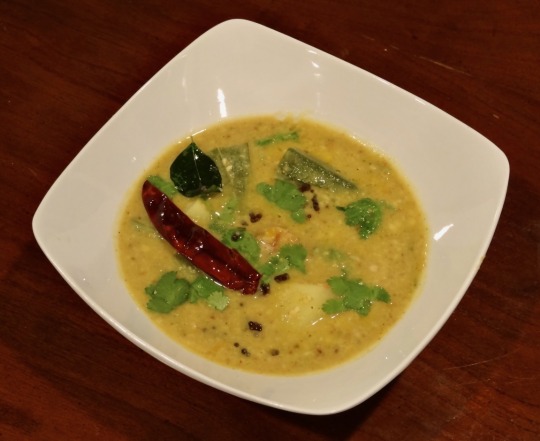
[ID: A bowl of a bright yellow stew topped with cilantro, mustard seed, chili, and curry leaf. End ID]
ಉಡುಪಿ ಸಾಂಬಾರ್ / Udupi sambar
A sambar is a lentil-and-vegetable stew distinguished by the use of a particular spice blend (Hindi: सांबर मसाला "sāmbār masālā," "sambar spice"; Kannada: ಸಾಂಬಾರ್ ಪುಡಿ "sāmbār puḍi," "sambar powder"). Sambars are a staple of South Indian and Sri Lankan cooking, sometimes made in households for multiple meals a week. The word "sambar" can be traced back to the Sanskrit सम्भार "sambhārá," "collection of things required for a particular purpose”; “spices."
The lentil used in sambar dishes is usually tur dal (split pigeon peas), though arhar dal, tuvur dal, or even blends containing masur or mung dal may be used, depending on the cook or the region. Vegetables also vary between combinations of okra, potato, ash gourd (petha), bottle gourd (doodhi / lauki), drumstick (saijan ki phalli), beetroot, tomato, carrot, pumpkin, brinjal, and pearl onions, among others. The sambar masala fries chilis, curry leaves, dal, and various spices including cumin, coriander, and fenugreek, then grinds them into a spicy, earthy, fragrant blend.
This recipe makes a sambar in the style of ಉಡುಪಿ (Udupi) cuisine—a subdivision of the cuisine of the ತುಳುವ (Tuluva) people localised in the Udupi District of Karnataka, a southeastern coastal state of India. (Tuluva cuisine is also commonly found in Dakshina Kannada, Karnataka, and Kasaragod, Kerala). In the Udupi region, sambar may be known as "ಕೊಡೆಲ್" "kodhel"; perhaps related to "ಕಡಲೆ" "kadhale" "Bengal gram"; or "ಹುಲಿ" "huḷi"; "tartness." Udupi huli has coconut oil and jaggery as its primary distinguishing features: the jaggery's deep sweetness and the earthy pungency of unrefined coconut oil combine with the spice of the chilis and the sour fruitiness of the tamarind to create a complex, flavorful, well-balanced dish.
Udupi huli may be further divided into a few major types. ಮಸಾಲೆ ಹುಳಿ ("masāla huḷi") contains shredded coconut and vegetables; ಬೋಳು ಹುಳಿ ("bolu huḷi") contains vegetables, but omits the coconut.
Hotel-style masala huli recipes typically add a lot of jaggery to produce a distinct sweetness; cut back on the amount of coconut included; and contain onion and garlic. The other main type of masala huli—“temple style”—is sattvic (from Sanskrit "सत्त्व" "sattva": "goodness," "essence," "existence"), which in this context means that onions and garlic are excluded.
A sattvic diet in Hinduism centres around the concept of maintaining sattva by eating only pure and mild (sattvic) foods, and omitting tamasic (“dark,” "inert," "destructive"; from Sanskrit तमस् "tamas") and rajasic ("exciting," "passionate," from Sanskrit रजस् "rajas") ones. The concepts of sattva, tamas, and rajas (the गुण "guṇa" system) are central to the construction of caste: the degree to which each person innately inherits each quality supposedly determines their possession of characteristics including honesty, intelligence, and goodness (sattva), stupidity and lack of creativity (tamas), and passion and pridefulness (rajas); the possession of these characteristics in turn determines their rightful place in a professional and social hierarchy. The association of certain foods with certain qualities thus links diet to caste: a distinction in diet is one of the methods by which those belonging to upper castes maintain and police caste boundaries.
This recipe makes enough pudi for one pot of sambar. Traditionally, sambar pudi is created fresh each time the dish is made, but many households make large batches and store them. In this case, omit the coconut; or, use dried coconut and store the masala in the refrigerator.
Recipe under the cut!
Patreon | Paypal | Venmo
Ingredients:
Serves 4-6.
For the sambar:
2 cups chopped vegetables
1 red onion, sliced*
1 cup (200g) yellow split pigeon peas / tur dal / ತೂರ್ ದಾಲ್ (ಹಳದಿ ಸ್ಪ್ಲಿಟ್ ಪಾರಿವಾಳದ ಬಟಾಣಿ)
4 cups (1 litre) water, or as needed
1/4 tsp ground turmeric / haldi / ಅರಿಶಿನ
2 tsp table salt
2 tsp jaggery / gur / ಬೆಲ್ಲ*
1/4 cup (60mL) tamarind pulp (from 1 Tbsp dried tamarind / imlie / ಹುಣಸೆಹಣ್ಣು)
2 tsp unrefined coconut oil / nariyal ka tel / ತೆಂಗಿನ ಎಣ್ಣೆ
Ingredient list format is English / Hindi (Latin transcription) / Kannada. The Hindi is provided for convenience while shopping.
Udupi sambar usually uses any of: gourd, brinjal (Indian eggplant), pumpkin, dumstick (saijan ki phalli), and okra. Pearl onion is not usually used in this region, but you can add whatever you want, according to taste.
*For a hotel-style sambar, include the onion; increase the jaggery to 2 Tbsp.
For the spice paste / sambar masala / ಸಾಂಬಾರ್ ಪುಡಿ ("sambar pudi"):
1/2 Tbsp split Bengal gram / chana dal / ಹಳದಿ ಸ್ಪ್ಲಿಟ್ ಗ್ರಾಂ
2 tsp split black gram / urad dal chilka / ಸ್ಪ್ಲಿಟ್ ಬ್ಲ್ಯಾಕ್ ಗ್ರಾಂ
2 tsp coriander seeds / dhaniya / ಕೊತ್ತಂಬರಿ ಬೀಜದ
1/2 tsp fenugreek seeds / methi / ಮೆಂತ್ಯ
1 tsp cumin seeds / jeera / ಜೀರಿಗೆ
1 tsp ground turmeric
5-6 curry leaves / kari pati / ಕರಿಬೇವು
3-4 Byadagi or other dried red chilis / byadagi mirch / ಬ್ಯಾಡಗಿ ಮೆಣಸಿನಕಾಯಿ
4 cloves garlic, skins on*
Large pinch asafoetida / hing / ಇಂಗು
1 cup (100g) fresh coconut (about one coconut)*
1/2 cup (120mL) water
While the ratio of ingredients in Udupi sambar pudi vary slightly, the ingredients themselves are almost always consistent.
*For a hotel-style sambar, include the garlic, and decrease the coconut in the sambar masala to 1/4 or 1/2 cup (25-50g).
The grams and pulses in this pudi have many different names. You can find them in a halal or South Asian grocery store; look on the bag for the Hindi names (since they have been transcribed into Latin, the spelling may vary from what you see here).
The urad dal you find may be husked, and thus yellow instead of black; these will work just as well.
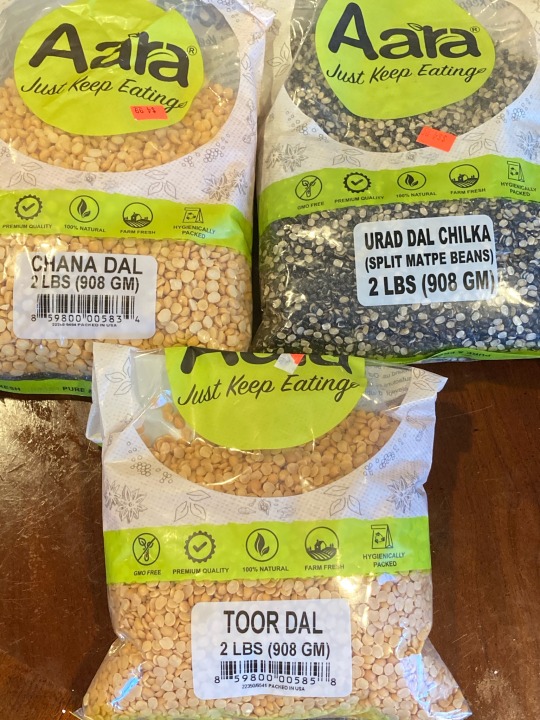
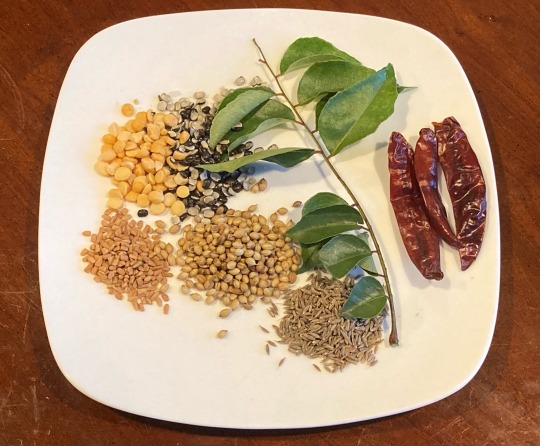
For the tempering / tadka / ಹದಗೊಳಿಸುವ:
2 Tbsp unrefined coconut oil
2 red chilis
8 curry leaves
1 tsp brown mustard seeds / rai / ಸಾಸಿವೆ ಬೀಜಗಳು
Recipes from north Karnataka may add cumin and whole, unpeeled garlic cloves to the tempering.
Instructions:
For the sambar pudi:
1. Break open the coconut and remove and shread its flesh.
If using a whole dried coconut, break into the shell with the wrong side of a hammer and pry open. Break into a few smaller pieces and peel with a vegetable peeler until the skin is removed from the white flesh, wearing something to protect your hand. Soak in warm water for several minutes to soften, and then grate or food process.

2. Heat 2 Tbsp of coconut oil in a skillet on medium-low. Add asafoetida and fry for 30 seconds, until no longer raw-smelling. Add dal and fry, stirring often, for 30 seconds until golden brown; add coriander, mustard, fenugreek, and cumin seeds and fry until fragrant.
3. Add curry leaves and fry until wilted, then add garlic and dried chilis and fry another 30 seconds to a minute, until fragrant.
4. Add coconut and fry, stirring often, for another few minutes until a shade darker. Add turmeric and stir.
5. Grind all ingredients into a paste in a mortar and pestle, then mix in about 1/2 cup water to loosen (if using dried coconut, you may need more water).
Or, put all ingredients along with 1/2 cup water into a blender or food processor and process until a relatively smooth paste forms.
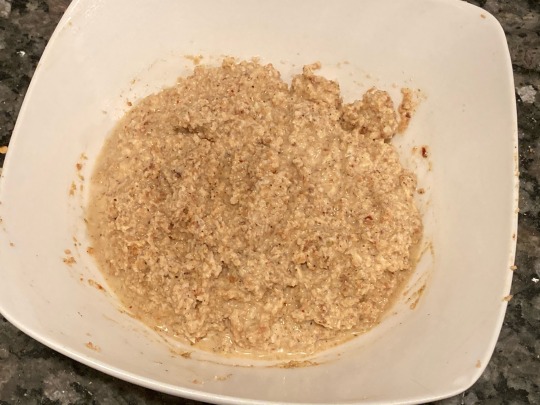
For the sambar:
1. Wash tur dal to remove excess starch. Simmer dal with 2 cups water, 1/4 tsp ground turmeric, and 1 tsp coconut oil for about 30 minutes until very tender. Mash until relatively smooth with a wooden spoon or bean masher, or process briefly with an immersion blender.
You may soak the dal in water after rinsing them to reduce the cooking time, but it is not necessary.
2. Meanwhile, make the tamarind paste. Soak 1 Tbsp tamarind dried pulp in 1/4 cup hot water for 20-30 minutes. Squeeze the tamarind into the water to extract the pulp. Discard the tamarind seeds and husk. Optionally, depending on your preferred texture, push the mixture through a metal sieve.
3. Prepare vegetables. Slice the onion; remove ends of okra and drumsticks and cut into 2-inch pieces; quarter tomatoes; quarter brinjal; peel pumpkin and cut into cubes; peel and cube potatoes.
4. If using onion, add a teaspoon of coconut oil to a large pot and fry until translucent.
5. In the same pot, boil vegetables in just enough water to cover, along with a pinch of salt, until they are beginning to soften.
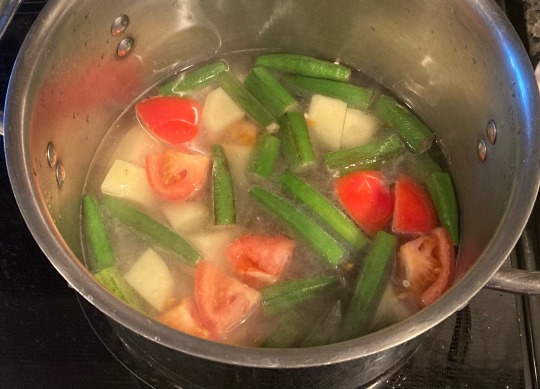
Some recipes call for the vegetables to be boiled, and others call for them to be steamed. I prefer boiling, since it produces a nice savory broth.
6. Mix vegetables, dal, tamarind, jaggery, sambar pudi, and salt to taste and simmer 5-10 minutes to allow flavors to combine and vegetables to cook under tender. Add water as needed. Remove from heat and stir in cilantro. Taste and adjust salt.
The final sambar should be pourable, like a thick soup—Karnataka sambar is typically thinner in consistency than Tamil Nadu versions.
For the tadka:
1. Heat coconut oil in a small skillet on medium heat. Add tempering ingredients and fry, stirring often, until chilis and curry leaves are a couple shades darker and the mixture is fragrant.
2. Pour the oil and tempering ingredients into the sambar and stir in. If you like, retain some of the tadka as a garnish to serve.
3. Serve warm, in individual bowls, alongside long-grain white rice. To eat drumsticks, scoop the center out and eat it; the tough outer rind is left.
If you intend to save some sambar, it's a good idea to make just enough tadka for what you plan to eat that day, and then make fresh tadka to pour over the reheated leftovers.
106 notes
·
View notes
Text

Baghdadi Jewish rabbi from India, late 19th century
The Persian Gulf port of Basra began to serve as a trading center in the 18th century. It was from there and other nearby cities that many Jews who played an important role in British commerce in the region gradually moved on to Mughal India. In the 1780s, hundreds of Jews from Aleppo, Baghdad and Basra made up the Jewish colony in the west coast port of Surat. Later the community thrived in the cities of Mumbai and Kolkata, making their fortune in cotton, jute, tobacco processing and opium trades. They adhered to the Judeo-Arab religious and social customs, which were strongly influenced by Islamic tradition. Middle Eastern dishes like the Koobe (stuffed dumplings) remain popular among the Baghdadi Jews, who have also incorporated Indian spices and tropical vegetables into their cuisine.
87 notes
·
View notes
Note
Re: your post on medieval peasant with spaghetti. Idk if you've answered this but I'm dying to know about the thing you mentioned with Indian food being traced back to a single guy
I’ve answered it a bunch of times but I’ll answer it real quick again. Babur was a guy who conquered India and didn’t like the food there and brought Mughal cuisine influence to the region. A lot of really basic ideas in Indian cuisine can be traced back to his invasion.
54 notes
·
View notes
Note
i would totally be in Scarabia
only because I would cry if i was in Heartslabyul or Pomefiore
they are very english and have not much in the way of spices
and jamie oliver uses chili jam
urk i still shiver when i think of that
the other reason would be that i am very used to 35 degree celsius and above weather and if i had to go to anywhere under 26 degrees i would shrivel up and die
(is jamie oliver supposed to be jamil....aslkajsfjk)
I did forget that Europe was a thing, as well as forgot that Heartslabyul and Pomefiore would be European. My seasonings…noooooooooooooo
My original answer still stands, personality-wise I match up best with Pomefiore but I think I'd be a good match in Scarabia too. I do wonder what their food would be. Aladdin is a weird mash of Arabic and Indian cultures, I think, so it's not as easy to assign a real world equivalent to Scalding Sands like the others. I think food wise at least, Jamil's favorite food is closer to Indian cuisine (there's like several ethnic/regions in India too tho soooo). Kalim likes coconut juice, but that's not native to either India or Arabic countries. I think… I forgot what this ask was originally about.
#mochi asks#twst#twisted wonderland#jamil viper#kalim al asim#im very passionate about food specifically can you tell
34 notes
·
View notes
Text
How to make Ayurvedic Spiced Ajwain Wali Chai
Ayurvedic Spiced Ajwain Wali Chai
To prepare Spiced Ajwain Wali Chai, the process typically involves brewing regular tea leaves or tea bags in water along with ajwain seeds and other spices like ginger powder, cardamom powder, pepper, basil, clove etc. The combination of these spices creates a warm, aromatic beverage that is believed to have digestive benefits and is commonly consumed in some…

View On WordPress
#ajwain#Ajwain Wali Chai#Ajwain Wali tea#Ayurvedic Spiced Ajwain Wali Chai#Ayurvedic Spiced Ajwain Wali Tea#bachlor recipes#beverages and drinks#bignners recipes#Easy Recipes#healthy recipes#how to make#indian chai#North Indian Recipes#Quick Recipes#Regional Indian Cuisine#Spiced Ajwain Wali Chai#Spiced Ajwain Wali tea#spiced tea#spicy veg recipes#Tea#veg recipes#winter recipes
2 notes
·
View notes
Text
Venba launches July 31
Gematsu Source

Narrative cooking game Venba will launch for PlayStation 5, Xbox Series, Xbox One, Switch, and PC via Steam on July 31 for $14.99, developer Visai Games announced. It will also be available via Xbox Game Pass.
Here is an overview of the game, via Visai Games:
About
Venba is a narrative cooking game, where you play as an Indian mom, who immigrates to Canada with her family in the 1980s. Players will cook various dishes and restore lost recipes, hold branching conversations and explore in this story about family, love, loss and more.
Cook Mouth Watering Dishes – Venba‘s recipe book gets damaged when she moves to Canada. Restore the lost recipes to cook delicious mouth watering dishes that serve as a connection to the home left behind.
Explore, Converse, Experience – Get to know the family well, hold branching conversations, explore as you face the challenges that arise from day to day life.
Key Features
Cook authentic and delicious recipes handpicked from regional southern Indian cuisine.
Hold branching conversations and explore different narrative beats.
Beautiful visuals and animations.
Unique soundtrack inspired by Indian musicals.
Watch a new trailer below.
Release Date Trailer
youtube
58 notes
·
View notes
Text
Get Ready for a Flavor Explosion: Uncovering India's Most Unique and Mouth-Watering Pickles!
India is a country known for its rich and diverse culinary traditions. One of the most distinctive aspects of Indian cuisine is its pickles. Indian pickles, also known as achar, are a unique combination of fruits, vegetables, spices, and oil that are preserved in vinegar or lemon juice. These pickles are an essential part of Indian cuisine and are often served as a condiment with meals. [READ:…

View On WordPress
#condiments#cultural heritage#fruits#indian cuisine#Lifestyle#pickles#recipes#regional specialties#side dishes#spices#traditional foods#unique flavors#vegetables
1 note
·
View note
Text
Deutschribing Germany
Cuisine
Meal times
The German proverb Iss dein Frühstück wie ein Kaiser, Mittagessen wie ein König und Abendessen wie ein Bettler (Eat your breakfast like an emperor, lunch like a king, and dine like a pauper) sums up the German outlook toward meals.
A typical day begins with Frühstück (breakfast), when people drink coffee, tea, or hot cocoa and eat muesli with yogurt or milk or bread with butter, jam, honey, chocolate and hazelnut spread, sausage, or cheese. Some people also drink juice and eat a boiled egg. This usually takes place between 6 and 8 a.m. Children usually eat a mid-morning snack at school called Pausenbrot (recess sandwich) that consists of a sandwich, a piece of fruit, or a muesli bar. The adult version is called Zwischenmahlzeit (in-between meal).
Mittagessen (lunch) takes place between 12 and 2 p.m. A typical lunch dish includes potato salad with sausage or meatballs and meat with potatoes or vegetables. It is common for family members and friends to gather between 3 and 5 p.m. for Kaffee und Kuchen (coffee and cake).
Abendessen (dinner) is eaten between 6 and 7 p.m. Sometimes it is a light cold meal with bread and cold cuts, in which case it is called Abendbrot (evening bread). Dinner normally consists of a salad or soup, bread, cheese, meat or sausages, mustard, and pickles.
Dishes
German cuisine varies from region to region, and what is considered typically German is actually typical in the south, mainly Bavaria, where cuisine is similar to that in Austria. There are also international varieties such as doner kebab, pizza, sushi, Chinese food, Greek food, Indian food, and Vietnamese food.
Bread and sausage are staples of the German diet. There are about 600 types of bread and almost 1,500 sausage varieties, including Bratwurst (made of ground pork, beef, or veal and spices) and Weißwurst (white sausage eaten with sweet mustard, a pretzel, and beer).
The national alcoholic drink is beer, of which there are many varieties, including Helles (a pale lager beer produced in southern Germany), Radler (a beer mixed with lemonade), and Weizenbier (a top-fermented beer brewed with a large proportion of wheat relative to the amount of malted barley).
Berliner/Krapfen/Pfannkuchen
These sweet dough dumplings, filled with jam and glazed with powdered sugar, are known as Berliner in northern and western Germany, Pfannkuchen in eastern Germany, and Krapfen in southern Germany.

Birnen, Bohnen und Speck
Birnen, Bohnen und Speck (pears, beans, and bacon) is a dish made with pears, green beans, and bacon, accompanied by potatoes. It is eaten in Bremen and Lower Saxony.

Bratkartoffeln
Bratkartoffeln (fried potatoes) are fried potato slices with diced bacon and/or onions.
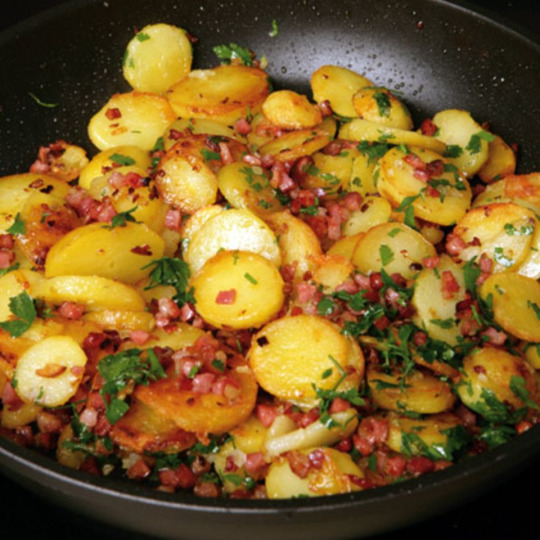
Brezel
Brezeln (pretzels) are baked pastries made from dough and shaped into a symmetrical knot. They are typically seasoned with salt, but can also have toppings such as cheese or seeds.
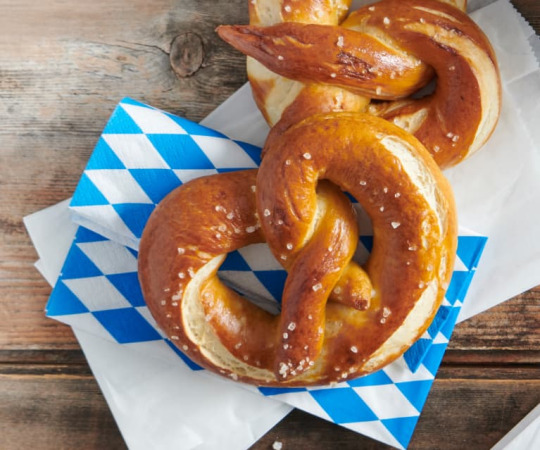
Brot
Brot (bread) comes in many different types, from white wheat bread (Weißbrot) to gray (Graubrot) to black (Schwarzbrot), which is actually dark brown rye bread. Some breads contain both wheat and rye flour and are called Mischbrot. Others have seeds such as linseed and sunflower seeds and are wholegrain (Vollkornbrot). Bread can also be made from spelt (Dinkelbrot), rye (Roggenbrot), or a mix of these with wheat.

Brötchen (bread rolls) are also very common and can be made from the same cereals and seeds as normal bread.
Currywurst
Currywurst is Berlin's most famous dish and consists of a pork sausage with ketchup and curry powder.
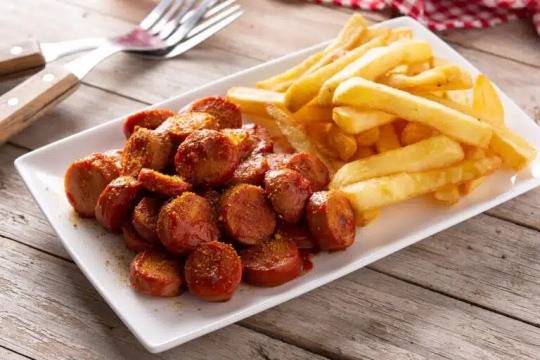
Eierschecke
Eierschecke, whose name is derived from a tripartite piece of clothing, consists of three layers: the bottom one is either a yeast dough or made with baking soda, the middle layer is a cream made of quark, vanilla, butter, egg, sugar, and milk, and the top one is made from eggs, butter, sugar, and vanilla pudding powder. It is a specialty from Saxony and Thuringia.

Fischbrötchen
A Fischbrötchen (fish bread roll) is a sandwich made with various fish, either pickled or fried, and onions, common in northern Germany.

Flammkuchen
Flammkuchen means "pie baked in the flames" and originates from Baden in Baden-Württemberg and the Palatinate in Rhineland-Palatinate. It is similar to a pizza with thin crust covered with crème fraîche, onions, and lardons.

Frikadellen
Frikadellen are flat-bottomed, pan-fried meatballs of minced meat. They are commonly eaten with pasta salad or potatoes, or in a bread roll with mustard.

Himmel und Erde
Himmel und Erde (heaven and earth) is a dish with mashed potatoes, stewed apples and fried blood pudding. Potatoes are also called Erdäpfel (ground apples), so it is a meal made with apples that grow above and under the earth. It is popular in the Rhineland in Rhineland-Palatinate and North Rhine-Westphalia, Westphalia in North Rhine-Westphalia, and Lower Saxony.
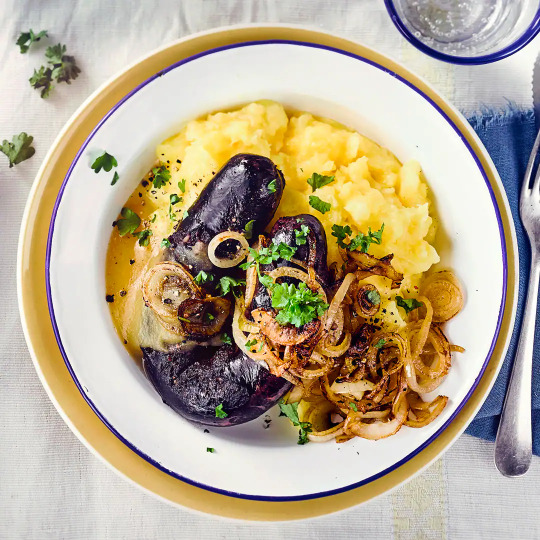
Kirschenmichel
Kirschenmichel is a kind of bread pudding made with cherries and served hot with vanilla sauce. It is typically eaten in Franconia in Bavaria and Thuringia, the Palatinate, Baden-Württemberg, and Hesse.

Klöße/Knödel
These dumplings are known as Klöße in northern, central, and western Germany and Knödel in southern Germany. They are usually made from flour, bread, or potatoes. There are different varieties, including dumplings made of ground liver or breadcrumbs.

Kohlroulade
A Kohlroulade (cabbage roll) consists of cooked cabbage leaves wrapped around a meat filling seasoned with garlic, onion, and spices. Rinderrouladen are similar but consist of bacon and onions wrapped in beef.

Labskaus
Labskaus is a dish made from corned beef, herring, mashed potatoes, and beetroot, served with a fried egg and a pickled cucumber. It is typically eaten in northern Germany.
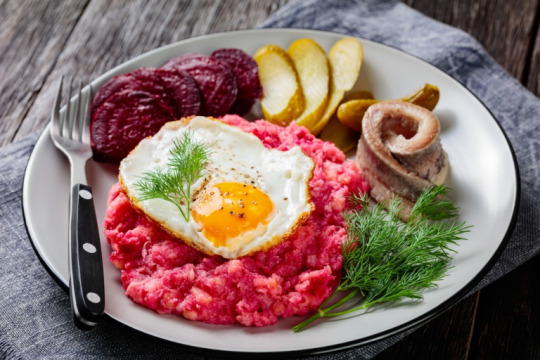
Leberkäse
Leberkäse ("liver-cheese") is eaten in Franconia, Saarland, and Swabia in Bavaria and Baden-Württemberg. It consists of beef, pork, and bacon that are finely ground and then baked as a loaf in a bread pan. It is served with an egg and mashed potatoes.

Leipziger Allerlei
Leipziger Allerlei was invented in Leipzig and consists of a mixture of peas, carrots, green beans, asparagus, morels, and celery. It may also contain broccoli, cauliflower, or corn. It is served with potatoes and a sauce made from crayfish butter, crayfish tails, and semolina dumplings.

Marmorkuchen
Marmorkuchen (marble cake) has a streaked appearance, achieved by lightly blending light and dark batter. It can be a mixture of vanilla and chocolate.

Maultaschen
Maultaschen ("mouth bags") are large meat-filled dumplings typical of Swabian cuisine. They can also be filled with spinach, onions, and spices and can be either served with broth or cut into slices and fried with eggs.

Pfefferpotthast
Pfefferpotthast (boiled meat pepper pot) is a traditional Westphalian stew made with beef, lard, onions, and spices. It is served with boiled potatoes and salad in the summer and pickled cucumbers and beetroot in the winter.
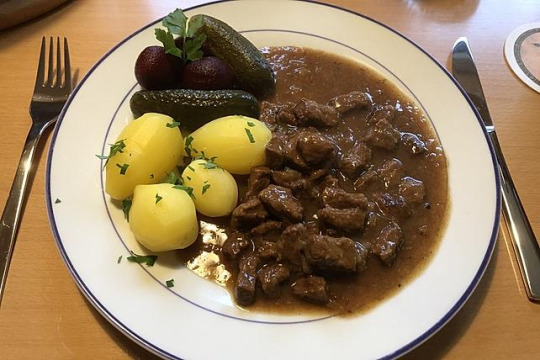
Pinkel mit Grünkohl
It is a dish made from slowly cooked kale served with Pinkel, a salty sausage eaten mainly in Bremen and Lower Saxony.
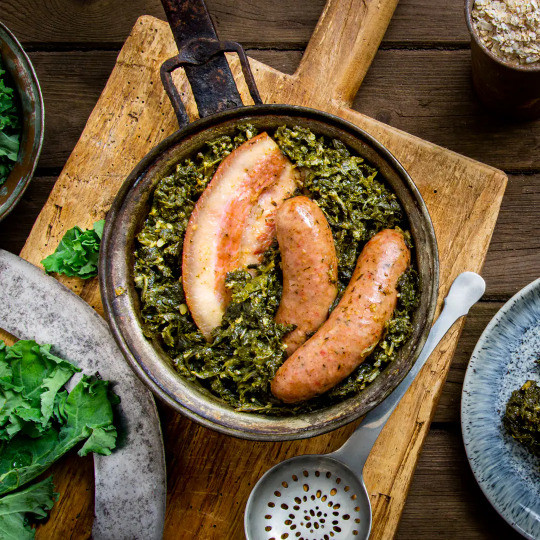
Quarkkäulchen
A Quarkkäulchen ("little quark ball") is a Saxon dish made from quark, mashed boiled potatoes, flour, an egg, and lemon peel. The dough is then baked in the form of a pancake and eaten hot with sugar and cinnamon or with fruit, whipped cream, and vanilla ice cream.

Reibekuchen
These potato pancakes are served with black bread, sugar beet syrup, or stewed apples. They are common in many areas of the country, but the name is characteristic to the Rhineland.

Rollmops
Rollmops ("rolled pug/fat young boy") are pickled herring fillets, rolled around a savory filling, usually consisting of onion and a pickle. It is a specialty from Berlin.

Sauerbraten
Sauerbraten is regarded as the national dish of Germany. It originally comes from the Rhineland and consists of large pieces of beef or horse meat, marinated in a spicy water-vinegar mixture before baking and served with Klöße.
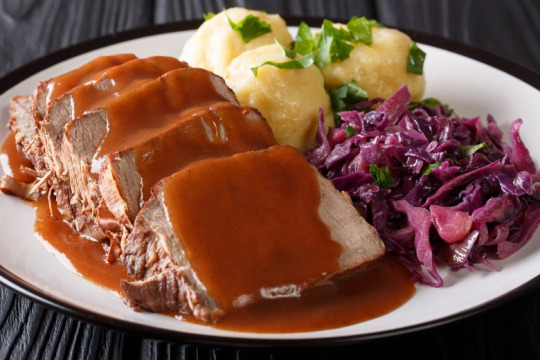
Sauerkraut
Sauerkraut is finely cut raw cabbage fermented by lactic acid bacteria.

Saumagen
Saumagen ("sow's stomach") is popular in the Palatinate and consists of a pork's stomach filled with pork, sausage meat, and potatoes. It is usually served with mashed potatoes or Bratkartoffeln and Sauerkraut.
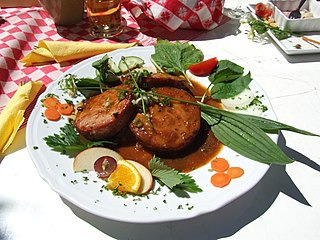
Schnitzel
A Schnitzel is a fried, breaded thin piece of meat, typically pork or beef. Although the most famous one is Wiener Schnitzel (Viennese style), there are other kinds, including Jägerschnitzel, with mushroom sauce; Rahmschnitzel, with cream sauce, and Zigeunerschnitzel, with a sauce made with tomato, bell peppers, and onion.

Schupfnudel
Schupfnudel are thick noodles typical of southern Germany. They are usually made from flour or potatoes and eggs and served with Sauerkraut.
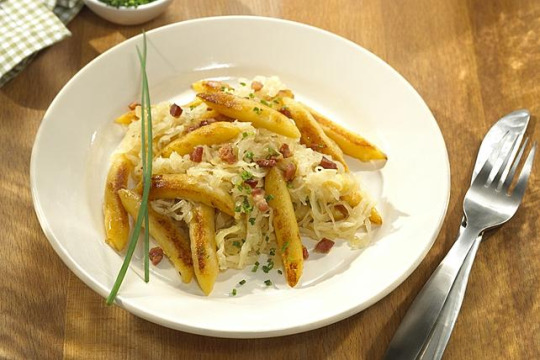
Schwarzsauer
Schwarzsauer ("black sour") is a North German blood soup with spices cooked in vinegar.

Schwarzwälder Kirschtorte
Black forest cake is a chocolate and whipped cream cake with a cherry filling and cherries on top.
Schweinshaxe
Schweinshaxe is a typical Bavarian dish of roasted ham hock served with Sauerkraut. A variation of this dish is known elsewhere as Eisbein ("ice leg"), in which the ham hock is pickled and slightly boiled.
Schwenkbraten
Schwenkbraten is a pork neck steak marinated in spices and onions. It is originally from the Saarland and grilled on a Schwenker, a grill that hangs on a chain over a wood fire.
Spaghettieis
Spaghettieis (spaghetti ice cream) is an ice cream dish made to resemble spaghetti. Vanilla ice cream is extruded through a modified Spätzle press to give it the appearance of spaghetti. It is placed over whipped cream and topped with strawberry sauce to simulate tomato sauce and either coconut flakes, grated almonds, or white chocolate shavings to represent Parmesan cheese.
Spätzle
Spätzle (little sparrow) are hand-made egg noodles, originally from Swabia. They are the main ingredient of several dishes, such as Käsespätzle (Spätzle with cheese) and Linsen mit Spätzle (lentils with Spätzle).
Streuselkuchen
Streuselkuchen ("crumb cake") is made of yeast dough covered with a sweet crumb topping (Streusel). The recipe originated in German Silesia.
47 notes
·
View notes
Text
Last Monday of the Week 2023-10-16
Another year older. Stealing the Untitled Wednesday Library Series format from Morrak for an open Reading section and then we'll get to the normal post.
Reading:
Untitled Monday Wednesday Library Entry No. 0
Do you like a recipe book? Do you like an unbearably comprehensive and frequently incorrect recipe book? Well boy do I have an item for you:

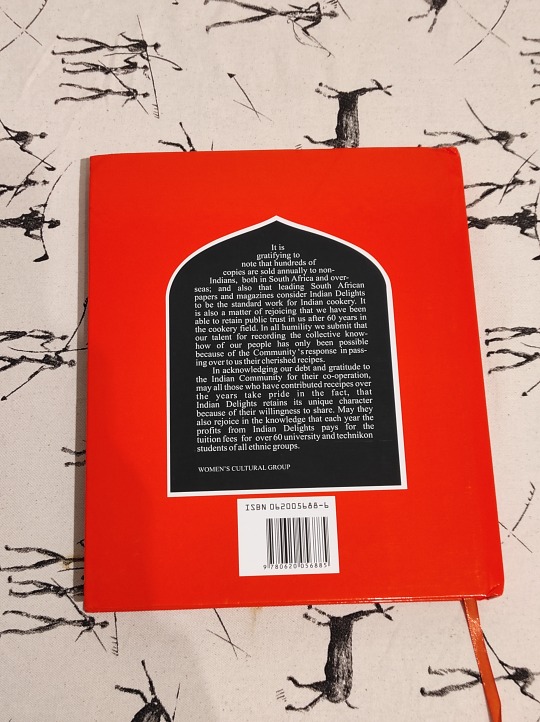
It's Indian Delights, the de facto standard book of South African Indian cooking. Assembled in the 60's by the Durban Women's Cultural Group and in print ever since then.
The How
A birthday gift from my parents, who sent it from South Africa.
There are apparently places that carry this book outside of South Africa but I do not know what those are.
The Text
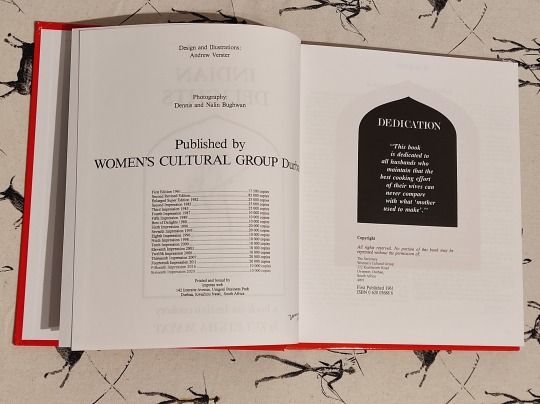
Dubious, but useful despite this. It was written in the 60's by a bunch of people who had never and would never again write a recipe book. You may note from the frontmatter that while it has had sixteen impressions since its first publication in 1961, there has only ever been a single revision of the book. There are numerous errors, omissions, and flaws. Recipes may list ingredients that are not used, call for ingredients in the method not given before, begin preparing components and never use them, or outright lie about the quantities of ingredients you need. A challenging exercise.
Any given individual's copy of this book is full of little pen notes, slips of paper, and scratched out experiments. I have a blank canvas.
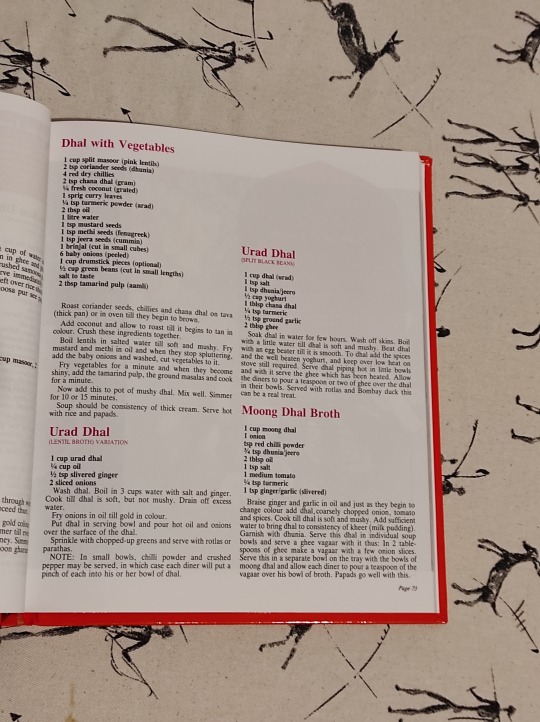

It is absolutely stuffed to the brim with recipes from the then-almost-century of South African development on South Asian cuisine. It is intended as a one-stop-shop for cooking from a diaspora of extremely wide origins.
South African Indians arrived in South Africa as indentured labour for British sugar farms and could just as easily be from the relatively cold and mountainous North Indian regions or the low, rainy, hot coastal areas of South India. As a result you've had almost a hundred years of adapting to the locally available ingredients, intermarriages across wide geographic origins, and failing memories. There are frequently many duplicates of any given recipe, each with some unique variation of note.

It is also extremely dated. It still lives in an era where "adding an elachi (cardamom) pod to your rice" is a luxurious choice that requires financial considerations, and where meat was still expensive. It also has a delightful section on mass cooking, such as the above "Biryani for 100 people" which has an additional note on the ingredients for a "Biryani for 800 people" on the opposite leaf. These things come up sometimes, although the largest biryani I've ever been involved in was for about 60 people.
It is not really for beginners but it does have a lot of introductory matter, in part because it has to contend with the mishmash of languages and loanwords that exist. You don't know if the reader uses the hindi word for cumin, or the tamil word for cumin, or makes a formal distinction between roti and chapati. As a result, there are extensive opening tables of translations.
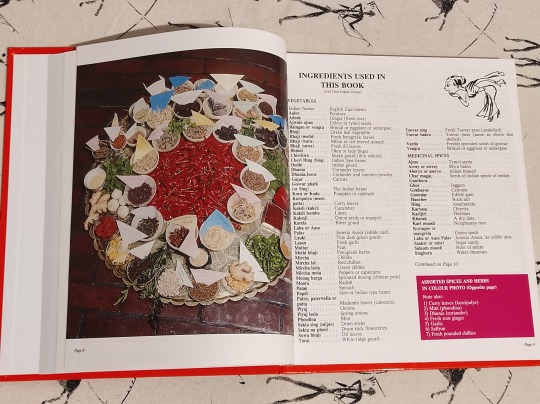
The Object

Big, blocky hardcover recipe book. Cheap but hardwearing coated pages. I have seen these in every imaginable state of disrepair, unfortunately I do not have a photo on hand of my mother's which is completely beat to hell.
I mentioned that there have not been many updates, and this continues to the outside. Not a single impression has, for example, corrected the misalignment of the spine and the cover that means it stands out on any book storage system.

Some damage to the cover from the rigours of air travel. It'll recover, or rather, it'll get beat up in ways that make that negligible.
The photography is antiquated, having been taken by a photographer who was certainly good but was operating a) with 1961 camera technology, b) 1961 photographic sensibilities, and c) no real experience in food photography. As a result the images can look somewhat alien if you're familiar with more modern food photograpy. Colours are not accurate, framing is flat, and composition is often packed.
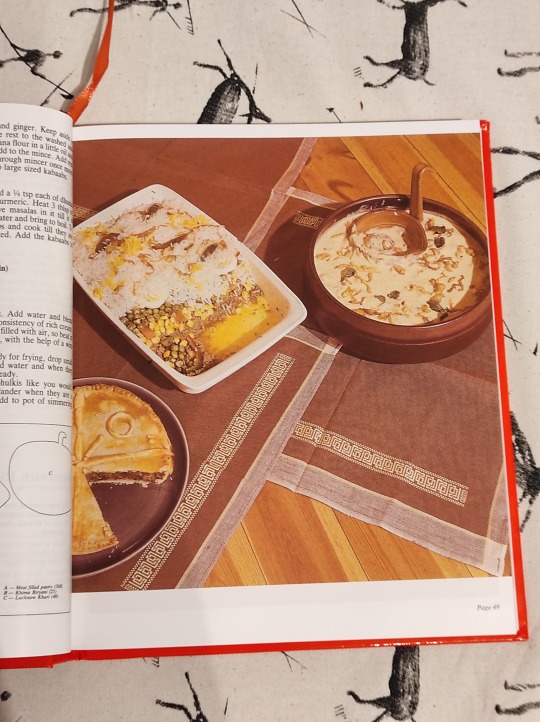
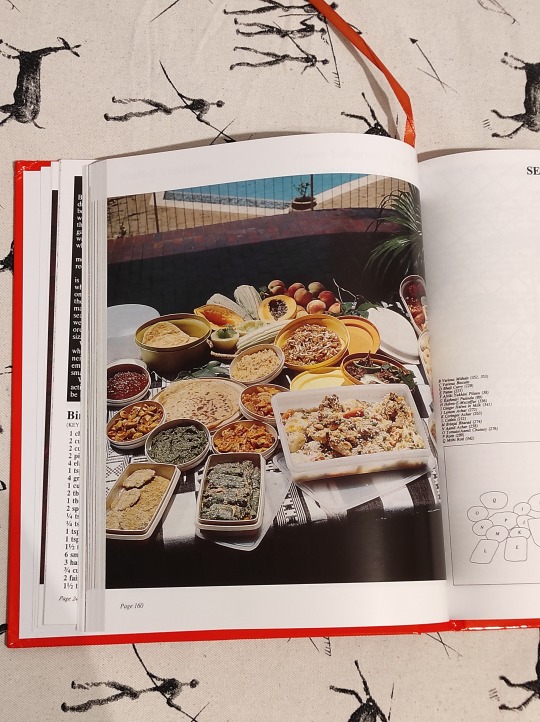
In addition to the colour glamour plates, there are black and white instructional photos, which are much more timeless.

The Why, Though?
Indian Delights is a very important cultural reference for the South African Indian population, and it's a pretty standard leaving home/getting married/leaving home and getting married gift. I've bought a copy for many friends and now this one is mine.
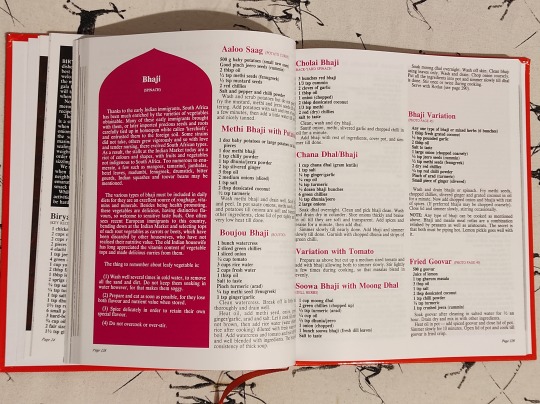
Will I actually use this much? Certainly not that often. My mother and her sisters learned to cook from this book, so it is the root of my personal culinary tradition. That means I already know a lot of what can be distilled from this for day-to-day recipes. Where it is handy is for more technical dishes, which require some guidance, or as an ingredient reference for something new you want to try.
In particular Diwali is coming up and while both my mother and I are staunch atheists, we will also take any excuse to make a ton of sweets for friends. If you are in Prague in the week of the 12th of November you can probably hit me up for something.
Listening: Acheney is a shockingly talented synth designer for the niche softsynth tracker sunvox, available now on windows, mac, linux, windows CE, android, and iOS. I was tooling around with their Guitar synths and decided to check out their music, which is a couple albums of very high concept EDM inspired ambient and/or noise stuff. Here's Euler Characteristic Zero
Watching: @humansbgone is an animated sci-fi series about intelligent giant arthropods and their attempts to deal with invasions of pesky little humans
youtube
Big spec-bio focus with a lot of end notes on the arthropods in question.
Playing: Played the Trans Siberian Railway Simulator demo, which I recorded and put up here, with crap audio because it's authentic to what I had lying around after I forgot my headphones at work.
youtube
Also: the digital version of the D&D themed agent placement game Lord of Waterdeep with my family, which works quite well. It's weird to have the game handling the admin of moving points around and automatically deducting resources, but it does make the game go very quickly, even if your parents are still figuring out the interface.
Making: Big cooking experiment with a slow roast lamb shank. Came out very well. Lamb shank definitely one of the more animal parts of an animal you can cook. Smells intensely of lanolin and other hair smells. Real greasy. Big honkin' bone. Smooth and fine but sturdy musculature. This thing used to be a very specific part of something alive and that thing lived the kind of life that develops the very particular smells of the insides of a sheep that are very close to the outside of a sheep. You will find some wool fibers in your pan from where the follicles reach down close to the bone and sinew.


Tools and Equipment: Easyeffects is the successor to PulseEffects and is a very complete set of audio tuning and manipulation tools for Linux. You can use it to process incoming and outgoing audio with basically any plugin you care to imagine.
#last monday of the week#Bandcamp#food#indian delights#south africa#recipe books#untitled wednesday library series
30 notes
·
View notes
Text
Thai Food You Should Eat Because of BL

Firstly most of these dishes have multiple spellings in English (and also often many different names within Thailand). I just picked one spelling, that will be enough to do a search, if you want to find a recipe for yourself.
Som Tum in What’s Zabb Man

AKA Green Papaya Salad
I think this is the one most people will know on this list. Unlike overseas, in Thailand there are many varieties of som tum (I’ve had an ocean-side version served with little blue crabs, raw and in the shell, AMAZING). It’s often a street food, and it’s usually quite spicy. You order by either asking the vendor (it’s traditionally served from market stalls just as we saw at the beginning of this show) for a heat level or number of chilis. The ingredients are then pounded together with a massive mortar & pestle. The order and amounts of the different ingredients are chef-specific, so the variety and uniqueness is immense with this dish. There are fans of it who make a point of trying as many different versions in each city they visit. Like being a wine taster.


Som Tum highlights what I think is best about Thai food - it’s bright forward freshness and deep complexity of flavors. Som Tum is the firework-in-your-mouth of salads: sour, sweet, salty, spicy, umami, herbaceous. It’s a spectacular dish (which has been ill served by it’s ubiquitousness outside of Thailand). It should be made fresh, (this is NOT a slaw), because if it sits at all the elements become soggy and the flavor muddled.


What’s Zabb Man emphasized the important aspects of this dish. Its spiciness and its freshness, the uniqueness of its flavor, not to mention how each chef makes it his own.
After all when Poon goes missing, Athip finds him again because, after one taste of his Som Tum, he knows who is in the kitchen.
Kao Soi in Bite Me

AKA Northern Thai Curry Noodle AKA Chiang Mai Curry Noodles
Did I do this post because I want to talk about this dish? Probubly. Here in the states it’s a rare to find on offer but it’s one of my absolute favorites.
I’m obsessed with diaspora foods in general - AKA fusion foods that highlight immigrant, colonial occupation, and/or blended communities. Lamb Vindaloo and Banh Mi are some famous examples of this. There was one banh mi place I found in Nor Cal run by a Chinese/Vietnamese couple that made a char siu pork + pâté banh mi, it was WILD and wicked good! Sorry, I digress.
This is a Northern Thai dish, common in Chang Mai, influenced by both Burmese (Myanmar) cuisine and local Chinese communities. It’s wildly variable by family and by region. This is also possibly one of my favorite foods. It’s notable in that it is one of the few traditional Thai dishes you will find served with chopsticks. (When I order it here in the states that’s one of the things I look for.)
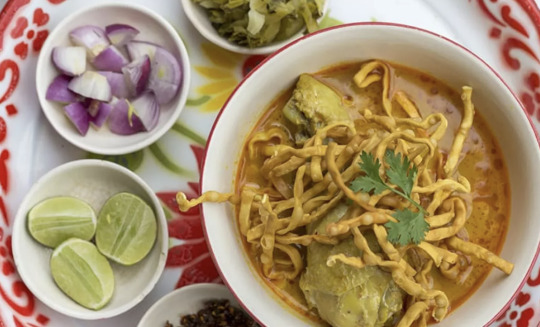
It is a noodle soup/stew. Can be rice, egg, or flour noodles, usually ramen style (but sometimes fettuccine), topped with a thick coconut forward curry broth, stewed dark meat chicken (usually on the bone) and raw onion. It has fried crispy flour noodles on top and is served with pickled vegetables, extra spices, fresh herbs, lime wedges, and raw shallots (or some combination thereof) - either on the top or on the side (banchan style). The curry element usually has more in common with Chinese or Japanese yellow curry powers (like those used for Singapore noodles) than red or green Thai curries. It combines what we would think of as traditional Thai flavor profiles with Chinese, and can also uses some Indian spices. It is a very layered dish, with more depth and earthiness and slightly less brightness than a lot of other Thai food. It tends to have a rounded heat to it (hitting all of the mouth, like Indian cuisine). I am a particular fan of the pickled greens element.
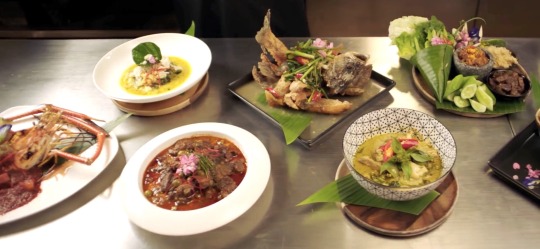
Bite Me is not a great BL but Aek sharing his Chiang Mai roots with Chef Aue, most specifically around this dish, is key to the plot (what little there is). But this is not a dish that is served in Chef Aue’s restaurant.
Khai Palo in Enchanté

AKA 5 Spice Pork & Egg Stew
This is the dish Theo remembers from his childhood that Akk’s family cooks for him. It’s a fascinating dish because it’s retains a very strong Chinese influence and is noted for using soy sauce as its salt element (rather than the more ubiquitous fish sauce) and for NOT being spicy, also it involves 5 spice.
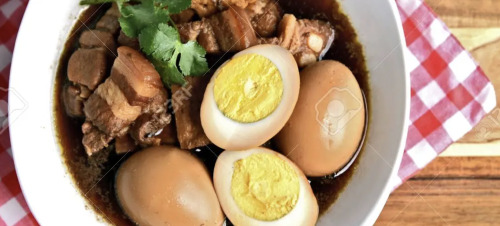
It’s also often associated with children or childishness and comfort food. It’s most commonly found as a street food or homemade, and is relatively rare in restaurants outside of Thailand. It has a similar flavor profile to Moo Gratiem which is one of my favorite dishes. (It’s that white peppercorn and garlic thing = NOM.) It’s also very easy to make, I recommend it. There is a Mama ramen noodle version you can sometimes find and buy, but I always need to add more five spice.

In Enchanté this dish is a plot point and is interesting because it highlights both the time when Theo was last in Thailand (as a child), Akk’s interest in courting and caring for him, and Theo’s somewhat childish nature/behavior.
Gaeng Tai Pla in Close Friend 2
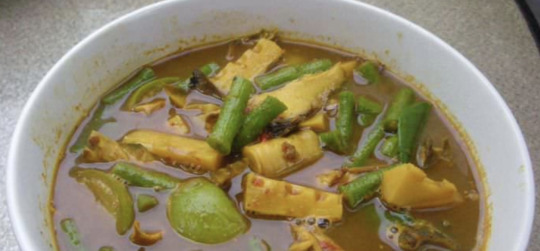
AKA pickled fish sour soup
A famous dish developed in the fishing communities of Southern Thailand. Traditionally it involves pickled fish bladder (Tai Pla) + large chunks of dried fish meat, Thai eggplant, bamboo shoots, and/or seasonal greens, with a spice profile similar to tom (lemongrass, lime, shrimp paste, red chili).
I've never been lucky enough to eat this, but it's on my hit list. I think I could make something like it, but I can’t get hold of the the Tai Pla for love nor money.
Luk Choup in La Cuisine (& Until We Meet Again)

AKA no other name, really, but this is also the main characters name in La Cuisine, ลูกชุบ (translation, coated pieces) but the meaning of this dessert is “loved by all, or adored.” This aspect of the name is a plot point in the series. Choup’s older brother, aunt, and grandmother all refer to him as the family’s beloved one, or special one, or most loved.
Luk Choup are tiny imitation fruits/vegetables (or occasionally star shapes) these are made of mung beans cooked with coconut milk and sugar. Once formed, they are dipped in gelatin and painted with food coloring to resemble other food. Recipe here.

This one appeared multiple times in Until We Meet Again, on the bus, at the fair, and at the very end during Dean and Pharm’s separation.
I’ve eaten these.
Consistency wise the exterior is like a gummy but much tougher, and with a bite to it. So like if you made jello into sheets but with too much gelatin. I’ve actually never had anything else to compare to this texture, perhaps like some of the bits in bubble teas? The interior is like very thick humus meets the inside of a peanut butter cup.

As for taste, the gel outside has no flavor and the inside tastes a lot like red bean paste. They are not very sweet.
Here’s a YT vid on how to make these.
Chor Muang in Until We Meet Again

AKA Blue Flower Dumpling
Chor Muang is a purple or blue flower-shaped dumpling that is savory, stuffed with a spiced minced chicken. These days it is a popular appetizer but it was once served as a dessert. The coloring is done with butterfly pea flour. Recipe here.

Chor Muang is a major catalyst food for the plot of Until We Meet Again. It is featured in a play starring Del and Manaow and is the reason Pharm meets and befriends Del. This allows him to start helping fix Dean’s strained family dynamic.

Later he feeds this dumpling to Team, Win, and Dean in front of witnesses. This is the first time he feeds Dean (it will not be the last.)
I did a post all about the sweets in this show. Here’s a YT vid on how to make these.
Nom Yen in SOTUS (also 2 Moons, 2 Moons 2)

AKA Pink Milk
Pink milk is pretty ubiquitous in most Thai BL series. Technically, its origin for association with BL is the original y-novel of 2 Moons. However, most international watchers are familiar with it from SOTUS (more recently it has shown up associated with side characters in Nitman and Love Area).

After watching SOTUS and both 2 Moons installments I got curious. Here’s the full post I did on pink milk, how it’s made and my experience attempting to recreate it. I can see why it might be thought of as a childish drink, it reminded me a bit of birthday cake flavoring, ice cream bean, or cotton candy. It’s very sweet and not a whole lot else.

THAI LANGUAGE CORNER
I haven’t learned the minutia yet but around ordering food in Thai but the Thai bestie always complains the monikers (also verbs?) for dishes have to do with what the dish is usually served inside. So some dishes have names/consumption verbs that have to do with bowls and others with plates.
Much as in English we would use the verb “drink” for broth but “eat” for soup. (And also argue about which one is appropriate under which circumstances.)
To train your ear for BL food:
gin = to eat or to have a meal (also under certain circumstances/sentence structures is slang for to sexually consume or fuck). See Pharm misuse this one in UWMA when Dean first visits his condo.
khao or kao = food but also actually rice, also a name and also third person he pronoun
talay = the ocean and also mixed seafood and a name
pad = usually means a stir fried (dryer) dish
pak = veggies!
kai (sounds like gai) = chicken ไก่ but also egg ไข่ (yes they are different in intonation and spelling, but really I find it darn near impossible to hear the difference)
A list of some common dishes is here.
Please leave a comment if any other dish has shown up you want to talk about, because this is basically my favorite topic EVER. I love to eat and cook Thai food so, yeah. Also the oft mentioned Thai bestie is an AMAZING cook. I often act the part of her kitchen goblin.

(source)
#thai food#thai cooking#thai bl#thai dishes#thai lanaguge#thai words#SOTUS#2 Moons#Nitman#Love Area the series#2 Moons 2#Until We Meet Again#Blue Flower Dumpling#Luk Choup#La Cuisine the series#Close Friend 2#Enchanté#bite me the series#noodles#What’s Zabb Man#Green Papaya Salad#food in bl#food in thai bl#plot point food
315 notes
·
View notes
Text
I've been on a bit of a curry powder kick with my recipes lately I think. curry powder is sooo interesting as a subject of study because of how much potential for localisation there is; the process of creating recipes for different regional blends of curry powder is really making me think about my philosophy with adapting dishes.
like, plenty of home cooks in China & Hong Kong will actually use imported curry powder from India or Malaysia to make Chinese curry, because they're "aiming at" a "foreign" flavor profile that was originally inspired by Indian cuisine (with this image of Indian cuisine being itself a result of colonisation, an innovation aimed at making the ~flavours of India~ more accessible to the English home cook in the 18th and 19th centuries—but Indian companies to-day do export "curry powder" blends to other English-speaking regions that they label "authentic" &c. &c.).
but this wouldn't be very interesting to me! I'm interested in and "aiming at" a specifically Hong Kongese adaptation of curry powder, and therefore I'm going to want to include as many Chinese ingredients as I can find 'attested' in Hong Kongese curry powder recipes (in my research into the spices used in commercial curry powder blends made and packaged in Hong Kong; home cook YouTube videos and interviews with restaurant owners based in Hong Kong; &c.). I'm never ad-libbing (i.e., adding in spices or aromatics that I don't see 'attested' in whatever local blends that I can find a trace of online), and I try to make the proportion of spices that I include in a blend basically adhere to the average of what I see in the recipes I consult (& the commercial blends, which don't list out proportions but do at least have some ingredients listed and organised in order of weight)—
but I still have my own tendencies that I'm interested in indulging (e.g., localised over generic; more over less; pungent over mild), and I'm able to fiddle around with all of those variables to produce a blend that is itself attested nowhere else, though each of its component ingredients can be traced back. so my recipe for Xinjiapo gali fen jumps at all of the 'Chinese' ingredients that Koon Yick Wah Kee includes (Sichuan peppercorns, Chinese black cardamom), but also includes more 'Indian' spices that other recipes include, but their's doesn't (e.g. green cardamom, fenugreek).
(as a side note for anyone who speaks French—on peut constater que the list of ingredients has been machine-translated from Chinese to English and thence to French, based on the fact that "star anise" has been rendered "tenez le primier rôle l'anis". other translation issues: what is listed as "dried parsley" in English [芫茜] is probably actually coriander seeds.)
25 notes
·
View notes